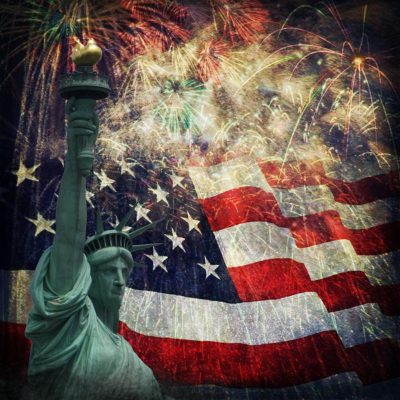
As we celebrate Independence Day, July 4th, I can’t help but remember that in 15 years of teaching college and asking students why we celebrate the 4th of July, only one knew the answer. Oh, many said “Independence Day,” but they didn’t know what happened or what year it happened. Please be sure your family and friends know that on July 4th, 1776, in Philadelphia, PA, the Continental Congress passed the Declaration of Independence.
We should all be proud Americans; despite our current challenges, we live in the best and freest nation in the world. Let’s end all the name calling and appreciate each other, even if we don’t all agree on everything.
Here are some of the significant things that happened in July: Lots of war. George Washington took command of our army in the Revolutionary War. The incredibly decisive battle at Gettysburg occurred during the Civil War. The Medal of Honor was created and the Vietnam War’s first one was earned. And some pilots really distinguished themselves.
On 1 July 1863, during the Civil War, the largest military conflict in North American history began when Union and Confederate forces collided at Gettysburg, Pennsylvania. The epic battle lasted three days and resulted in a retreat to Virginia by Robert E. Lee’s Army of Northern Virginia.
Two months prior to Gettysburg, Lee had dealt a stunning defeat to the Army of the Potomac at Chancellorsville, Virginia. He then made plans for a Northern invasion in order to relieve pressure on war-weary Virginia and to seize the initiative from the Yankees. His army, numbering about 80,000, began moving on June 3. The Army of the Potomac, commanded by Joseph Hooker and numbering just under 100,000, began moving shortly thereafter, staying between Lee and Washington, DC. Hooker was replaced by George Meade.
Meade took command as Lee’s army moved into Pennsylvania. On the morning of July 1, advance units of the forces came into contact with one another just outside of Gettysburg. The sound of battle attracted other units, and by noon the conflict was raging. During the first hours of battle, the Yankees found that they were outnumbered. The battle lines ran around the northwestern rim of Gettysburg. The Confederates applied pressure all along the Union front, and they slowly drove the Yankees through the town.
By evening, the Federal troops rallied on high ground on the southeastern edge of Gettysburg. As more troops arrived, Meade’s army formed a three-mile long, fishhook-shaped line running from Culp’s Hill on the right flank, along Cemetery Hill and Cemetery Ridge, to the base of Little Round Top. The Confederates held Gettysburg and stretched along a six-mile arc around the Union position. Lee’s forces would continue to batter each end of the Union position, before launching the infamous Pickett’s Charge against the Union center on July 3.
On 1 July 1898, during the Spanish-American War, as part of their campaign to capture Spanish-held Santiago de Cuba on the southern coast of Cuba, the US Army Fifth Corps engaged Spanish forces at El Caney and San Juan Hill.
In May 1898, one month after the outbreak of the Spanish-American War, a Spanish fleet docked in the Santiago de Cuba harbor after racing across the Atlantic from Spain. A superior US naval
force arrived soon after and blockaded the harbor entrance. In June, our Army’s Fifth Corps landed on Cuba with the aim of marching to Santiago and launching a coordinated land and sea assault on the Spanish stronghold. Included among our ground troops were the Theodore Roosevelt-led “Rough Riders,” a collection of Western cowboys and Eastern blue bloods officially known as the First US Voluntary Cavalry.
Our Fifth Corps fought its way to Santiago’s outer defenses, and on July 1, General William Shafter ordered an attack on the village of El Caney and San Juan Hill. Shafter hoped to capture El Caney before besieging the fortified heights of San Juan Hill, but the 500 Spanish defenders of the village held off 10 times their number for most of the day. Although El Caney was not secure, some 8,000 Americans pressed forward toward San Juan Hill.
Hundreds fell under Spanish gunfire before reaching the base of the heights, where the force split up into two flanks to take San Juan Hill and Kettle Hill. The Rough Riders were among the troops in the right flank attacking Kettle Hill. When the order was given by Lieutenant John Miley that “the heights must be taken at all hazards,” the Rough Riders, who had been forced to leave their horses behind because of transportation difficulties, led the charge up the hills. The Rough Riders and the black soldiers of the 9th and 10th Cavalry regiments were the first up Kettle Hill, and San Juan Hill was taken soon after. From the crest, the Americans found themselves overlooking Santiago, and the next day they began a siege of the city.
On July 3, the Spanish fleet was destroyed off Santiago by US warships under Admiral William Sampson, and on July 17 the Spanish surrendered the city–and thus Cuba–to the Americans.
On 2 July 1926, the US Army Air Service became the Army Air Corps. Then, after WWII, the Air Corps became the US Air Force on 18 Sept 1947.
On 3 July 1775, George Washington rode out in front of the American troops gathered at Cambridge common in Massachusetts and drew his sword, formally taking command of the Continental Army. Washington, a prominent Virginia planter and veteran of the French and Indian War, had been appointed commander in chief by the Continental Congress two weeks before. In agreeing to serve the American colonies in their war for independence, he declined to accept payment for his services beyond reimbursement of future expenses.
On 4 July 1776, in Philadelphia, Pennsylvania, the Continental Congress adopted the Declaration of Independence, which proclaimed the independence of a new United States of America from Great Britain and its king. The declaration came 442 days after the first shots of the American Revolution were fired at Lexington and Concord in Massachusetts and marked an ideological expansion of the conflict that would eventually involve France’s intervention on behalf of the Americans. The declaration was formally adopted by 12 colonies after minor revision. New York, the 13th colony, approved it on July 19. On August 2, the declaration was signed. The American War for Independence would last for five years. Yet to come were the Patriot triumphs at Saratoga, the bitter winter at Valley Forge, the intervention of the French and the final victory at Yorktown in 1781. In 1783, with the signing of the Treaty of Paris with Britain, the US formally became a free and independent nation.
On 6 July 1964, at Nam Dong in the northern highlands of South Vietnam, an estimated 500-man Viet Cong battalion attacked an American Special Forces outpost. During a bitter battle, Capt. Roger Donlon, commander of the Special Forces A-Team, rallied his troops, treated the wounded, and directed defenses although he himself was wounded several times. After 5 hours of fighting, the Viet Cong withdrew. The battle resulted in an estimated 40 Viet Cong killed; 2 Americans, 1 Australian military adviser, and 57 South Vietnamese defenders also lost their lives. At a White House ceremony in December 1964, President Lyndon Johnson presented Captain Donlon with the first Medal of Honor of the Vietnam War.
On 8 July 1776, a 2,000-pound copper-and-tin bell now known as the “Liberty Bell” rings out from the tower of the Pennsylvania State House (now Independence Hall) in Philadelphia, summoning citizens to the first public reading of the Declaration of Independence. Four days earlier, the historic document had been adopted by delegates to the Continental Congress, but the bell did not ring to announce the issuing of the document until the Declaration of Independence returned from the printer on July 8.
On 11 Jul 1941, Congress reconfirmed the military “status” of the Coast Guard, stating: “The Coast Guard shall be a military service and constitute a branch of the land and naval forces of the United States at all times and shall operate under the Treasury Department in time of peace and operate as part of the Navy, subject to the orders of the Secretary of the Navy, in time of war or when the President shall so direct.”
On 12 July 1862, during the Civil War, President Abraham Lincoln signed into law a measure calling for the awarding of a US Army Medal of Honor, in the name of Congress, “to such non-commissioned officers and privates as shall most distinguish themselves by their gallantry in action, and other soldier-like qualities during the present insurrection.” The previous December, Lincoln had approved a provision creating a US Navy Medal of Valor, which was the basis of the Army Medal of Honor. The first soldiers to receive what would become the nation’s highest military honor were six members of a Union raiding party who in 1862 penetrated deep into Confederate territory to destroy bridges and railroad tracks between Chattanooga, Tennessee, and Atlanta, Georgia. In 1863, the Medal of Honor was made a permanent military decoration available to all members, including commissioned officers, of our military. It is conferred upon those who have distinguished themselves in actual combat at risk of life beyond the call of duty. Since its creation, during the Civil War, almost 3,400 men and one woman have received the Medal of Honor for heroic actions in US military conflict.
On 15 July 1943, during WWII, Marine Captain Joe Foss bagged three Japanese planes for a record total of 26 kills. He was the Marines leading fighter ace during WWII and received the Medal of Honor, recognizing his role in the air combat during the Guadalcanal Campaign. In postwar years, he achieved fame as a General in the Air National Guard, the 20th Governor of South Dakota, President of the National Rifle Association, and the first commissioner of the American Football League.
On 16 Jul 1862, during the Civil War, David Glasgow Farragut, in recognition of his victory at New Orleans, promoted to Rear Admiral, the first officer to hold that rank in the history of the US Navy. Rear Admirals were to rank with Major Generals in the Army.
On 16 Jul 1957, Marine Maj. John Glenn set a transcontinental speed record when he flew a jet from California to New York in 3 hours, 23 minutes and 8 seconds.
Humor/Puns:
A girl Potato and boy Potato had eyes for each other, and finally they got married and had a little sweet potato which they called ‘Yam,’ Of course, they wanted the best for Yam, and when it was time they told her about the facts of life.
They warned her about going out and getting half-baked, so she wouldn’t get accidentally mashed, and get a bad name for herself like ‘Hot Potato,’ and end up with a bunch of tater tots.
Yam said not to worry, no spud would get her into the sack and make a rotten potato out of her, but on the other hand she wouldn’t stay home and become a couch potato either. She would get plenty of exercise so as not to be skinny like her shoestring cousins.
When she went off to Europe, Mr. And Mrs. Potato told Yam to watch out for the hard-boiled guys from Ireland and the greasy guys from France called the French fries. Yam said she would stay on the straight and narrow and wouldn’t associate with those high class Yukon Golds, or the ones from the other side of the tracks who advertise their trade on all the trucks that say, ‘Frito Lay.’
Mr. And Mrs. Potato sent Yam to Idaho P.U. (that’s Potato University) so that when she graduated she’d really be in the chips. But in spite of all they did for her, one-day Yam came home and announced she was going to marry Tom Brokaw.
Tom Brokaw!
Mr. And Mrs. Potato were very upset. They told Yam she couldn’t possibly marry Tom Brokaw because he’s just…..
Are you ready for this?
Are you sure?
OK!
Here it is!
” A COMMONTATER “
The Frontlines of Freedom Newsletter is published twice monthly; the dates of publication each month depend on the events and history of that month.









